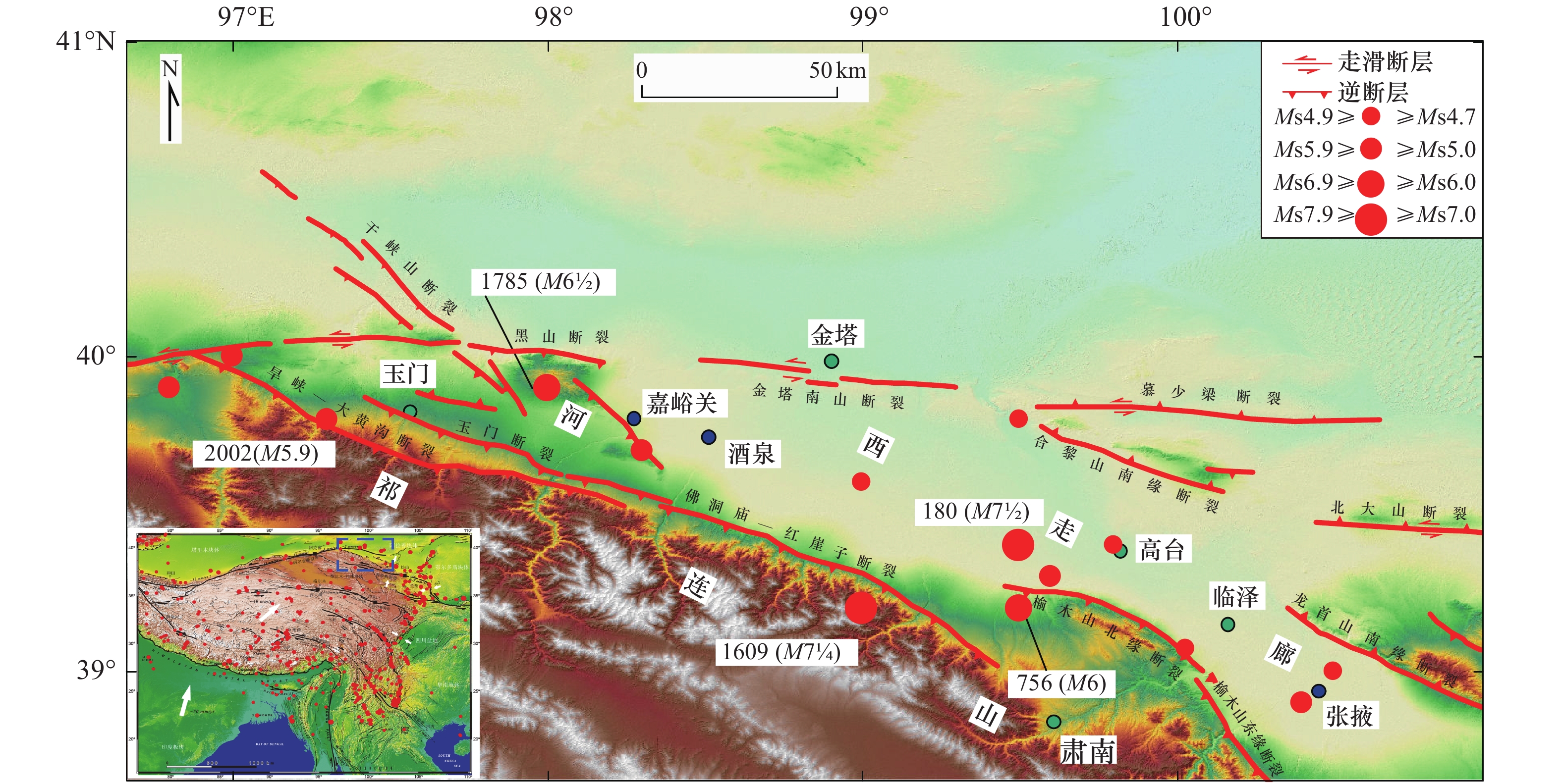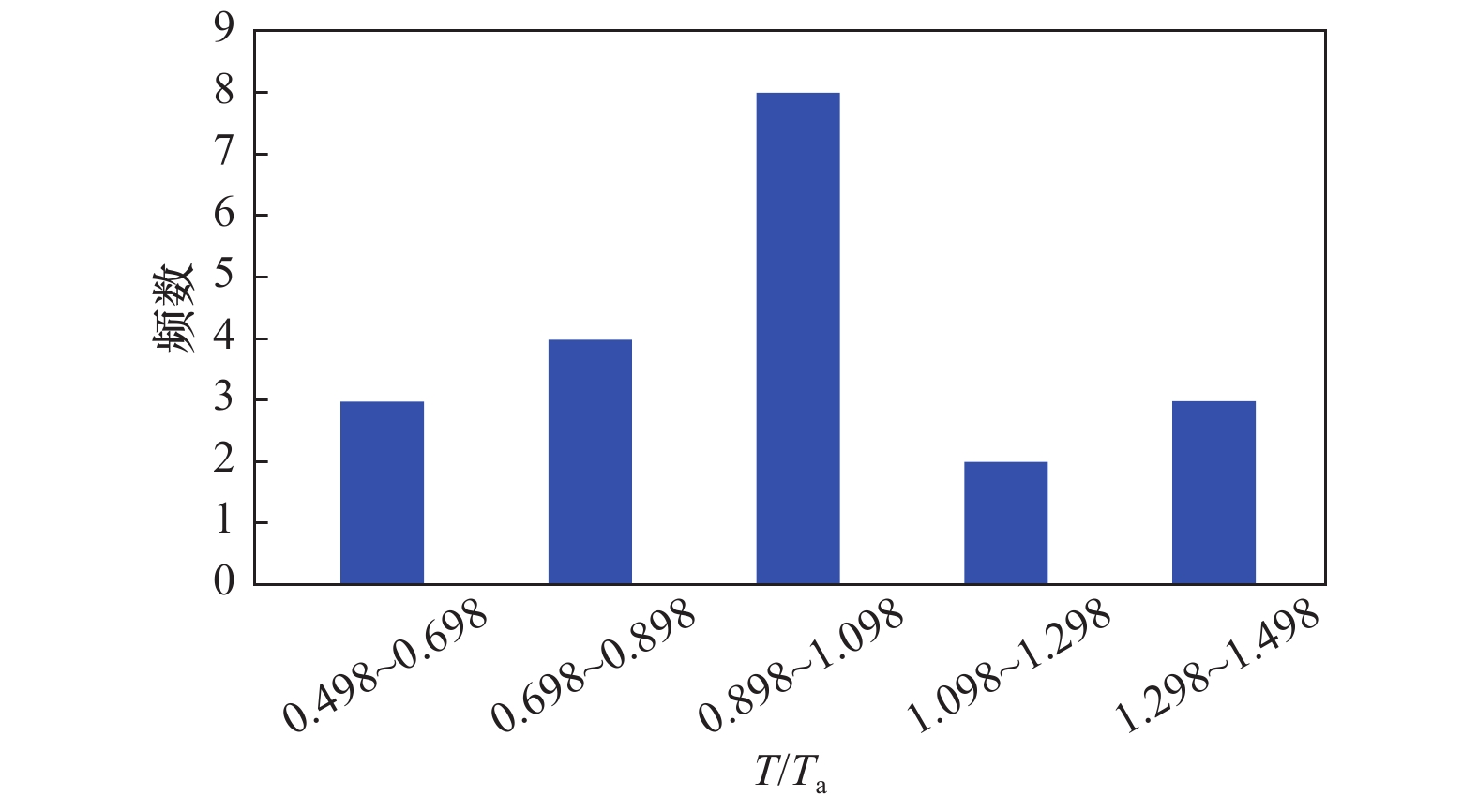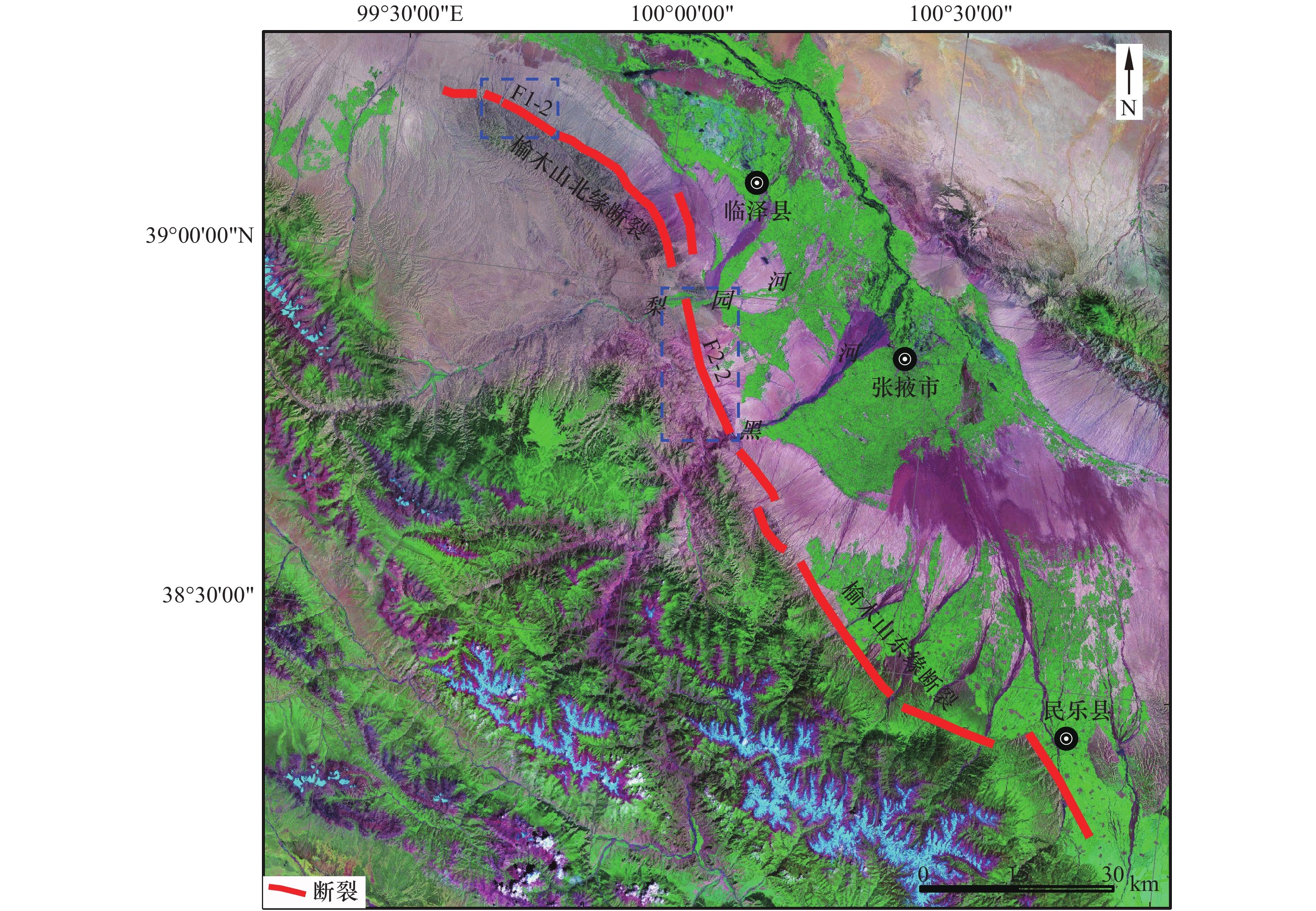Probability Model for Strong Earthquake Recurrence and Estimates of Seismic Potential in Western Qilian Mt.-Hexi Corridor
-
摘要: 祁连山-河西走廊西段构造区发育多条重要活动断裂,多年来已积累较丰富的古地震研究的成果。本文在前人研究基础上,结合历史地震数据等,从定量化强震复发间隔T与平均复发间隔Ta入手,将其比值(T/Ta)进行数学处理,借鉴NB模型的思路,建立祁连山-河西走廊西段构造区模型,进而对强震潜势进行评估。结果表明:祁连山-河西走廊西段构造区内未来可能的强震发生地点是榆木山北缘断裂芦泉河-九个泉段和榆木山东缘断裂梨园河口-黑河口段。
-
关键词:
- 祁连山-河西走廊西段 /
- 强震 /
- 概率分布 /
- T/Ta值
Abstract: Multiple important active faults are developed in western Qilian Mt.- Hexi Corridor, and quantitative research, especially systematic summary on paleoe-earthquakes are carried out in these years.This paper starts with paleoearthquakes and historic and recent earthquakes recurrence intervals for main active fault zones in western Qilian Mt.-Hexi Corridor since Late Pleistocene. By drawing lessons from modeling method of NB model, we have calculated the strong earthquake recurrence interval (T), average strong earthquake recurrence interval (Ta) and value of normalized function (T/Ta) for all specific fault segments, and established the strong earthquake recurrence probability model which shows that the distribution of normalized strong earthquake recurrence internal follows a normal distribution with mean (μ) equal to 1 and standard deviation (σ) of 0.224 3. The result reveals that the potential fault segments for the occurrence of future strong earthquake should be Luquanhe-Jiugequan segment of northern margin fault of Yumushan and Liyuanhe estuary-Heihe estuary part of eastern margin fault of Yumushan. -
表 1 研究区主要断裂
Table 1. Introduction of main faults in the study area
断裂名称 产状 分段依据 分段 合黎山断裂 长度:65 km
走向:N50°~60°W
倾向:N
倾角:40°~70°断层地貌
断层走向西段:肖家庄-阴埃墩
中段:阴埃墩-红土沟
东段:红土沟-猴儿头金塔南山断裂 长度:60 km
走向:近EW
倾向:S
倾角:>60°断层地貌
几何形态西段:梧桐墩-瓜勾山东
中段:瓜勾山东-大口子山
东段:大口子山-红墩西旱峡-大黄沟断裂 长度:160 km
走向:NWW
倾向:SW
倾角:40°~70°— — 玉门-北大河断裂 长度:130 km
走向:NWW
倾向:SW
倾角:20°~40°断层地貌
活动性西段:青草湾-南坪
东段:南坪-佛洞庙榆木山北缘断裂 长度:60 km
走向:NW
倾向:SW
倾角:40°~60°断层地貌
活动性西段:元山子-芦泉河
中段:芦泉河-九个泉
东段:排路口至梨园小口子榆木山东缘断裂 长度:110 km
走向:NNW
倾向:SWW
倾角:65°~70°断层地貌
活动性①南丰-民乐
②民乐-花寨子
③花寨子-大苦水
④大苦水-黑河口
⑤黑河口-梨园河口
⑥梨园河口-杨家庄佛洞庙-红崖子断裂 长度:110 km
走向:NW
倾向:SW
倾角:30°~45°几何形态
地层切割
关系西段:洪水坝河-红山村
中段:红山村东-马营河
东段:马营河-西岔沟龙首山南缘断裂 长度:400 km
走向:NW-NWW-EW
倾向:NE
倾角:70°~80°— — 表 2 研究区主要历史地震
Table 2. Main historical earthquakes in the study area
时间 历史地震 宏观震中 震中烈度 发震断裂 地表破裂长度 最大同震位错 震级厘定 180年 表氏地震 高台县北
(39.65°N,99.85°E)IX~X 合黎山断裂 >65 km 3 m $7\frac{1}{2}$ 756年 张掖-酒泉地震 高台县北
(39.6°N,100.0°E)IX~X 合黎山断裂 >30 km
(红土沟-猴儿头段)1.5 m 7~$7\frac{1}{2}$ 1609年 酒泉红崖堡地震 红崖堡西
(39.2°N,99.0°E)X 佛洞庙-红崖子断裂 95 km
(洪水坝河-头到东湾)1.8 m $7\frac{1}{2}$ 1785年 玉门惠回堡地震 玉门火烧沟近
(39.9°N,97.9°E)IX 新民堡断裂阴洼山断裂 — — $6\frac{3}{4}$ 2002年 玉门地震 (39.7°N,97.2°E) VII 旱峡-大黄沟断裂 — — 5.9 表 3 祁连山-河西走廊西段主要活动断裂(段落)强震复发间隔数据
Table 3. Strong earthquake recurrence intervals on some active faults in western Qilian Mt.-Hexi Corridor
断裂名称 段落名称 事件序列 时间/ a B.P. 距离上次事件时间间隔/a 重复间隔分组/a 平均重复间隔/a 均一化值 榆木山北缘断裂 芦泉河-九个泉 1 (13200±100) — — — — 2 8 382±74 4 818 4 818 4 818 — 3 6 511±65 1 871 1 871 — 0.97 4 4 533±43 1 978 1 978 1 924 1.03 榆木山东缘断裂 梨园河口-黑河口 1 (25 000) — — — — 2 (24 500) — — — — 3 15 700 — — — — 4 13 150±150 2 550 2 550 — 0.95 5 10 500 2 650 2 650 — 0.99 6 8 750±250 1 750 1 750 — 0.65 7 5 000 3 750 3 750 2 675 1.40 临泽段 1 8 895±125 — — — — 2 6 718±39 2 177 2 177 — 1.01 3 4 960±27 1 758 1 758 — 0.82 4 2 438±40 2 522 2 522 2 152 1.17 佛洞庙-红崖子断裂 — 1 10 600 — — — — 2 7 100 3 500 3 500 — 1.03 3 3 400 3 700 3 700 — 1.09 4 410 3 000 3 000 3 400 0.88 金塔南山断裂 梧桐墩西-瓜勾山东 1 6470±1.93 — — — — 2 3 530±280 2 940 2 940 — 1.45 3 1810±140 1 720 1 720 — 0.85 4 410±200 1 400 1 400 2020 0.69 瓜勾山东-红墩西 1 15 160±1290 — — — — 2 9 900±500 5 260 5 260 — 1.35 3 6 000 3 900 3 900 — 1.00 4 3 500±400 2 500 2 500 3 887 0.64 玉门-北大河断裂 — 1 8 330 — — — — 2 4 490 3 840 3 840 — 1.17 3 1 790 2 700 2 700 3 270 0.82 4 (1 140) 650 650 650 — 合黎山断裂 — 1 (5 000) — — — — 2 (1 939) 3 061 — — — 3 (1 263) 676 — — — 注:计算时剔除括号内的数据:(1)距今大于25 000a的地震数据,因其已超过地震复发周期;(2)单个地震的复发间隔值,无统计意义 表 4 祁连山-河西走廊西段构造区活动断裂(段落)地震潜势定量评估表
Table 4. Quantitative estimates of seismic potential on some active faults in western Qilian Mt.-Hexi Corridor
断裂名称 段落名称 离逝时间/a B.P. 平均复发间隔/a 消失率* 累计概率/% 文中所建模型 BPT模型 榆木山北缘断裂 芦泉河-九个泉 4533 1 924 2.408 100.00 97.88 榆木山东缘断裂 梨园河口-黑河口 5000 2675 1.906 100.00 93.89 临泽段 2438 2152 1.179 72.34 69.00 佛洞庙-红崖子断裂 — 410 3400 0.150 0 0 金塔南山断裂 梧桐墩西-瓜勾山东 410 2020 0.252 0 0 瓜勾山东-红墩西 3500 3887 0.926 32.86 50.94 玉门-北大河断裂 — 1140 3270 0.379 0.18 2.10 注:*预测时段为100年 -
[1] 曹娜, 雷中生, 袁道阳等, 2010. 公元180年甘肃表氏地震考. 地震学报, 32(6): 744—753.Cao N., Lei Z. S., Yuan D. Y., et al., 2010. Textural criticism on the Biaoshi, Gansu, earthquake in 180 A D. Acta Seismologica Sinica, 32(6): 744—753. (in Chinese) [2] 陈柏林, 刘建生, 张永双等, 2005. 玉门断裂全新世活动特征及其与玉门地震的关系. 地质论评, 51(2): 138—142. doi: 10.3321/j.issn:0371-5736.2005.02.004Chen B. L., Liu J. S., Zhang Y. S., et al., 2005. Activity of the Yumen fault during the Holocene and its relation to the Yumen earthquake. Geological Review, 51(2): 138—142. (in Chinese) doi: 10.3321/j.issn:0371-5736.2005.02.004 [3] 陈柏林, 王春宇, 宫红良等, 2007. 关于河西走廊盆地榆木山北缘断裂晚第四纪活动特征的新认识. 地质通报, 26(8): 976—983. doi: 10.3969/j.issn.1671-2552.2007.08.009Chen B. L., Wang C. Y., Gong H. L., et al., 2007. A new understanding of the characteristics of late Quaternary activity of the northern Yumushan marginal fault in the Hexi corridor, northwestern China. Geological Bulletin of China, 26(8): 976—983. (in Chinese) doi: 10.3969/j.issn.1671-2552.2007.08.009 [4] 陈家鼎, 刘婉如, 汪仁官, 1983. 概率统计讲义. 北京: 高等教育出版社. [5] 陈立春, 冉勇康, 2002. 京西北盆岭构造区强震复发概率模型及地震潜势的定量评估. 地震地质, 24(1): 91—100. doi: 10.3969/j.issn.0253-4967.2002.01.009Chen L. C., Ran Y. K., 2002. Probability model for strong earthquake recurrence and quantitative estimates of seismic potential in the basin-and-range province, northwest of Beijing. Seismology and Geology, 24(1): 91—100. (in Chinese) doi: 10.3969/j.issn.0253-4967.2002.01.009 [6] 陈立春, 2003. 河套断陷带的古地震、强震复发规律和未来可能强震地点. 北京: 中国地震局地质研究所.Chen L. C., 2003. Paleoearthquakes, the law of strong earthquake recurrence and potential sites for the occurrence of future strong earthquakes in the Hetao fault-depression zone. Beijing: Institute of Geology, China Earthquake Administration. (in Chinese) [7] 邓起东, 1991. 活动断裂研究的进展与方向. 见: 《活动断裂研究》编委会主编, 活动断裂研究(1). 北京: 地震出版社. [8] 邓起东, 陈立春, 冉勇康, 2004. 活动构造定量研究与应用. 地学前缘, 11(4): 383—392. doi: 10.3321/j.issn:1005-2321.2004.04.005Deng Q. D., Chen L. C., Ran Y. K., 2004. Quantitative studies and applications of active tectonics. Earth Science Frontiers, 11(4): 383—392. (in Chinese) doi: 10.3321/j.issn:1005-2321.2004.04.005 [9] 国家地震局地质研究所, 国家地震局兰州地震研究所, 1993. 祁连山-河西走廊活动断裂系. 北京: 地震出版社. [10] 何文贵, 郑文俊, 赵广堃等, 2004. 2002年12月14日甘肃玉门5.9级地震的发震构造研究. 地震地质, 26(4): 688—697. doi: 10.3969/j.issn.0253-4967.2004.04.014He W. G., Zheng W. J., Zhao G. K., et al., 2004. Study on the seismogenic structure of the Yumen, Gansu province Ms5.9 earthquake of December 14, 2002. Seismology and Geology, 26(4): 688—697. (in Chinese) doi: 10.3969/j.issn.0253-4967.2004.04.014 [11] 何文贵, 雷中生, 袁道阳等, 2010. 1785年玉门惠回堡地震的震灾特点与发震构造. 西北地震学报, 32(1): 47—53.He W. G., Lei Z. S., Yuan D. Y., et al., 2010. Disaster characteristics of Huihuipu earthquake in 1785 in Yumen, Gansu Province, and discussion on its seismogenic structure. Northwestern Seismological Journal, 32(1): 47—53. (in Chinese) [12] 何文贵, 袁道阳, 王爱国等, 2012. 酒泉盆地北侧金塔南山北缘断裂西段全新世活动特征. 地震, 32(3): 59—66. doi: 10.3969/j.issn.1000-3274.2012.03.007He W. G., Yuan D. Y., Wang A. G., et al., 2012. Active faulting features in Holocene of the west segment of the Jintananshan north-margin fault at the north of Jiuquan basin. Earthquake, 32(3): 59—66. (in Chinese) doi: 10.3969/j.issn.1000-3274.2012.03.007 [13] 黄雄南, 杨晓平, 杨海波, 2018. 佛洞庙-红崖子断裂古地震事件. 地震地质, 40(4): 753—772. doi: 10.3969/j.issn.0253-4967.2018.04.003Huang X. N., Yang X. P., Yang H. B., 2018. Study on paleoearthquakes along the Fodongmiao-Hongyazi fault, Gansu province. Seismology and Geology, 40(4): 753—772. (in Chinese) doi: 10.3969/j.issn.0253-4967.2018.04.003 [14] 金卿, 2011. 榆木山断裂带晚第四纪构造活动与大震危险性评价. 兰州: 中国地震局兰州地震研究所.Jin Q., 2011. Study on activity in late quaternary and the earthquake risk assessment of the Yumu mountain fault zone. Lanzhou: China Earthquake Administration Lanzhou Institute of Seismology. (in Chinese) [15] 金卿, 何文贵, 史志刚等, 2011. 榆木山北缘断裂古地震特征研究. 地震地质, 33(2): 347—355. doi: 10.3969/j.issn.0253-4967.2011.02.008Jin Q., He W. G., Shi Z. G., et al., 2011. Palaeo-earthquake study on the northern Yumushan active fault. Seismology and Geology, 33(2): 347—355. (in Chinese) doi: 10.3969/j.issn.0253-4967.2011.02.008 [16] 雷中生, 袁道阳, 郑文俊等, 2012. 756年张掖-酒泉地震考. 西北地震学报, 34(1): 72—77.Lei Z. S., Yuan D. Y., Zheng W. J., et al., 2012. Textural research of Zhangye-Jiuquan earthquake in 756 A. D. Northwestern Seismological Journal, 34(1): 72—77. (in Chinese) [17] 李安, 王晓先, 张世民等, 2016. 祁连山北缘玉门断裂晚更新世以来的活动速率及古地震. 地震地质, 38(4): 897—910. doi: 10.3969/j.issn.0253-4967.2016.04.008Li A., Wang X. X., Zhang S. M., et al., 2016. The Slip rate and paleoearthquakes of the Yumen fault in the northern Qilian mountains since the late Pleistocene. Seismology and Geology, 38(4): 897—910. (in Chinese) doi: 10.3969/j.issn.0253-4967.2016.04.008 [18] 李有利, 李保俊, 杨景春, 1995. 甘肃张掖黑河口断层晚更新世晚期以来的活动. 北京大学学报(自然科学版), 31(3): 351—357.Li Y. L., Li B. J., Yang J. C., 1995. Late quaternary movement on the Heihekou fault, west Gansu, China. Acta Scientiarum Naturalium (Universitatis Pekinensis), 31(3): 351—357. (in Chinese) [19] 李玉龙, 邢成起, 1988. 河西走廊地质构造基本特征以及榆木山北麓与黑河口上龙王活断层研究. 西北地震学报, 10(2): 35—47.Li Y. L., Xing C. Q., 1988. Research on the fundamental characteristics of the geological structures of the Hexi corridor and the active faults of the northern and eastern flank of the Yumushan mountain. Northwestern seismological Journal, 10(2): 35—47. (in Chinese) [20] 刘淑琴, 张中信, 1997. 概率论与数理统计. 长春: 吉林人民出版社.Liu S. Q., Zhang Z. X., 1997. Probability theory and mathematical statistics. Changchun: Jilin People’s Press. (in Chinese) [21] 刘兴旺, 雷中生, 袁道阳等, 2011. 1609年甘肃红崖堡7¼级地震考证. 西北地震学报, 33(2): 143—148.Liu X. W., Lei Z. S., Yuan D. Y., et al., 2011. Textual research on the Hongyapu M7.25earthquake in 1609. Northwestern Seismological Journal, 33(2): 143—148. (in Chinese) [22] 刘兴旺, 袁道阳, 何文贵, 2014. 祁连山北缘佛洞庙-红崖子断裂古地震特征初步研究. 震灾防御技术, 9(3): 411—419. doi: 10.11899/zzfy20140307Liu X. W., Yuan D. Y., He W. G., 2014. Preliminary study of palaeo-earthquakes on the Fodongmiao-Hongyazi fault in the north margin of Qilian mountain. Technology for Earthquake Disaster Prevention, 9(3): 411—419. (in Chinese) doi: 10.11899/zzfy20140307 [23] 庞炜, 2015. 祁连山前逆冲断裂带古地震识别的关键技术研究. 兰州: 中国地震局兰州地震研究所.Pang W., 2015. Key techniques in paleoearthquake studies of reverse faults on Qilian mountain piedmont. Lanzhou: China Earthquake Administration Lanzhou Institute of Seismology. (in Chinese) [24] 庞炜, 张波, 何文贵等. 2018. 金塔南山断裂中东段古地震特征初步研究. 地震地质, 40(4): 801—817. doi: 10.3969/j.issn.0253-4967.2018.04.006Pang W., Zhang B., He W. G., et al., 2018. Preliminary study of paleoearthquakes on the middle-eastern segment of Jinta Nanshan fault. Seismology and Geology, 40(4): 801—817. (in Chinese) doi: 10.3969/j.issn.0253-4967.2018.04.006 [25] 庞炜, 何文贵, 张波, 2019. 临泽断裂新活动特征初步研究. 地震研究, 42(1): 120—132. doi: 10.3969/j.issn.1000-0666.2019.01.016Pang W., He W. G., Zhang B., 2019. Preliminary study of new faulting characteristic of the Linze fault. Journal of seismological Research, 42(1): 120—132. (in Chinese) doi: 10.3969/j.issn.1000-0666.2019.01.016 [26] 冉勇康, 李志义, 尤惠川等, 1988. 河西走廊黑河口断层上的古地震及年代研究. 地震地质, 10(4): 118—126.Ran Y. K., Li Z. Y., You H. C., et al., 1988. The study and dating of paleoearthquake along Heihekou fault in Hexi corridor. Seismology and Geology, 10(4): 118—126. (in Chinese) [27] 冉勇康, 邓起东, 1999. 大地震重复特征与平均重复间隔的取值问题. 地震地质, 21(4): 316—323. doi: 10.3969/j.issn.0253-4967.1999.04.004Ran Y. K., Deng Q. D., 1999. Recurrence behavior of large earthquakes and how to take average recurrence interval of large earthquakes. Seismology and Geology, 21(4): 316—323. (in Chinese) doi: 10.3969/j.issn.0253-4967.1999.04.004 [28] 数学手册编写组, 1979. 数学手册. 北京: 人民教育出版社. [29] 宋春晖, 2006. 青藏高原北缘新生代沉积演化与高原构造隆升过程. 兰州: 兰州大学.Song C. H., 2006. Tectonic uplift and Cenozoic sedimentary evolution in the northern margin of the Tibetan Plateau. Lanzhou: Lanzhou University. (in Chinese) [30] 闻学泽, 1991. 活断层的定量研究与长期地震潜势的概率估计问题. 见: 《活动断裂研究》编委会主编, 活动断裂研究(1). 北京: 地震出版社. [31] 闻学泽, 1995. 活动断裂地震潜势的定量评估. 北京: 地震出版社.Wen X. Z., 1995. Quantitative estimates seismic potential on faults. Beijing: Seismological Press. (in Chinese) [32] 闻学泽, 1999. 中国大陆活动断裂的段破裂地震复发行为. 地震学报, 21(4): 411—418. doi: 10.3321/j.issn:0253-3782.1999.04.011Wen X. Z., 1999. Recurrence behaviors of segment-rupturing earthquakes on active faults of the China mainland. Acta Seismologica Sinica, 21(4): 411—418. (in Chinese) doi: 10.3321/j.issn:0253-3782.1999.04.011 [33] 杨海波, 杨晓平, 黄雄南, 2017. 祁连山北缘断裂带中段晚第四纪活动速率初步研究. 地震地质, 39(1): 20—42. doi: 10.3969/j.issn.0253-4967.2017.01.002Yang H. B., Yang X. P., Huang X. N., 2017. A preliminary study about slip rate of middle segment of the northern Qilian thrust fault zone since late Quaternary. Seismology and Geology, 39(1): 20—42. (in Chinese) doi: 10.3969/j.issn.0253-4967.2017.01.002 [34] 张波, 何文贵, 庞炜等, 2016. 青藏块体北部金塔南山断裂晚第四纪走滑活动的地质地貌特征. 地震地质, 38(1): 1—21. doi: 10.3969/j.issn.0253-4967.2016.01.001Zhang B., He W. G., Pang W., et al., 2016. Geological and geomorphic expressions of late Quaternary strike-slip activity on Jinta Nanshan fault in northern edge of Qing-Zang block. Seismology and Geology, 38(1): 1—21. (in Chinese) doi: 10.3969/j.issn.0253-4967.2016.01.001 [35] 张培震, 毛风英, 1996. 活动断裂定量研究与中长期强地震危险性概率评价. 见: 《活动断裂研究》编委会主编, 活动断裂研究(5). 北京: 地震出版社. [36] 张秋文, 张培震, 1999. 地震中长期预测研究的进展和方向. 地球科学进展, 14(2): 147—152. doi: 10.3321/j.issn:1001-8166.1999.02.007Zhang Q. W., Zhang P. Z., 1999. Progress and prospect in the studies on long and medium-term earthquake prediction. Advance in Earth Sciences, 14(2): 147—152. (in Chinese) doi: 10.3321/j.issn:1001-8166.1999.02.007 [37] 郑文俊, 2009. 河西走廊及其邻区活动构造图像及构造变形模式. 北京: 中国地震局地质研究所.Zheng W. J., 2009. Geometric pattern and active tectonics of the Hexi Corridor and its adjacent regions. Beijing: Institute of Geology, China Earthquake Administration. (in Chinese) [38] Anderson J. G., 1979. Estimating the seismicity from geological structure for seismic-risk studies. Bulletin of the Seismological Society of America, 69(1): 135—158. [39] Carlson J. M., 1991. Time intervals between characteristic earthquakes and correlations with smaller events: an analysis based on a mechanical model of a fault. Journal of Geophysical Research: Solid Earth, 96(B3): 4255—4267. doi: 10.1029/90JB02474 [40] Ellsworth W. L., Matthews M. V., Nadeau R. M., et al., 1999. A physically-based earthquake recurrence model for estimation of long-term earthquake probabilities. In: Workshop on Earthquake Recurrence: State of the Art and Directions for the Future. Rome: Istituto Nazionale de Geofisica, 1—20. [41] Gaudemer Y., Tapponnier P., Meyer B., et al., 1995. Partitioning of crustal slip between linked, active faults in the eastern Qilian Shan, and evidence for a major seismic gap, the ‘Tianzhu gap’, on the western Haiyuan Fault, Gansu (China). Geophysical Journal International, 120(3): 599—645. doi: 10.1111/j.1365-246X.1995.tb01842.x [42] Kagan Y. Y., Jackson D. D., 1991. Seismic gap hypothesis: ten years after. Journal of Geophysical Research: Solid Earth, 96(B13): 21419-21431. doi: 10.1029/91JB02210 [43] Molnar P., 1979. Earthquake recurrence intervals and plate tectonics. Bulletin of the Seismological Society of America, 69(1): 115—133. [44] Nishenko S. P., Buland R., 1987. A generic recurrence interval distribution for earthquake forecasting. Bulletin of the Seismological Society of America, 77(4): 1382—1399. [45] Savage J. C., Cockerham R. S., 1987. Quasi-Periodic occurrence of earthquakes in the 1978-1986 Bishop-Mammoth Lakes Sequence, eastern California. Bulletin of the Seismological Society of America, 77(4): 1347—1358. doi: 10.1785/BSSA0770041347 [46] Schwartz D. P., Coppersmith K. J., 1984. Fault behavior and Characteristic earthquakes: Examples from the Wasatch and San Andreas Fault Zones. Journal of Geophysical Research: Solid Earth, 89(B7): 5681—5698. doi: 10.1029/JB089iB07p05681 [47] Shimazaki K., Nakata T., 1980. Time-predictable recurrence model for large earthquakes. Geophysical Research Letters, 7(4): 279—282. doi: 10.1029/GL007i004p00279 [48] Tapponnier P., Meyer B., Avouac J. P., et al, 1990. Active thrusting and folding in the Qilian Shan, and decoupling between upper crust and mantle in northeastern Tibet. Earth and Planetary Science Letters, 97(3—4): 382—403. doi: 10.1016/0012-821X(90)90053-Z [49] Wallace R. E., 1970. Earthquake recurrence intervals on the San Andreas fault. GSA Bulletin, 81(10): 2875—2890. doi: 10.1130/0016-7606(1970)81[2875:ERIOTS]2.0.CO;2 [50] Wesnousky S. G., 1986. Earthquakes, Quaternary faults, and Seismic hazard in California. Journal of Geophysical Research: Solid Earth, 91(B12): 12587—12631. doi: 10.1029/JB091iB12p12587 [51] Xiao W. J., Mao Q. G., Windley B. F., et al., 2010. Paleozoic multiple accretionary and collisional processes of the Beishan orogenic collage. American Journal of Science, 310(10): 1553—1594. doi: 10.2475/10.2010.12 [52] Xu X. W., Yeats R. S., Yu G. H., 2010. Five short historical earthquake surface ruptures near the Silk Road, Gansu Province, China. Bulletin of the Seismological Society of America, 100(2): 541—561. doi: 10.1785/0120080282 [53] Zheng W. J., Zhang P. Z., Ge W. P., et al., 2013. Late Quaternary slip rate of the South Heli Shan Fault (northern Hexi corridor, NW China) and its implications for northeastward growth of the Tibetan plateau. Tectonics, 32(2): 271—293. doi: 10.1002/tect.20022 -




 下载:
下载:



